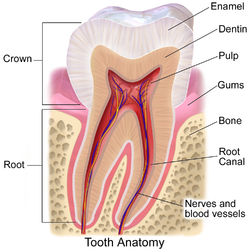Anatomy and Development of Dental Pulp
- The pulp is the central neurovascular bundle of each tooth, consisting of a central pulp chamber, pulp horns, and radicular canals.
- The size of the pulp chamber decreases with age.
- The dental pulp is derived from the dental papilla during tooth development.
- Odontoblasts and pulpoblasts differentiate within the dental papilla to form the dental pulp.
- Coronal and root pulp development occur in different regions of the tooth.
Pulp Innervation and Function
- The dental pulp is innervated by the trigeminal nerve and the sympathetic division of the autonomic nervous system.
- The pulp has multiple functions, including dentin formation, nutritive supply, sensory perception, defense and repair.
Pulp Diagnoses and Complications
- Pulp testing methods include vitality tests, sensitivity tests, electric pulp tests, and thermal tests.
- Pulp diagnoses include normal pulp, reversible pulpitis, and irreversible pulpitis.
- Irreversible pulpitis is characterised by inflammation and infection beyond healing, often requiring root canal treatment.
- Pulp necrosis occurs when the pulp dies or is dying, and can lead to infection, abscesses, and bone loss.
- Complications of pulp-related issues include decay, increased sensitivity, trauma-induced inflammation, and age-related changes.
Pulp Stones
- Pulp stones are calcified structures found in the dental pulp.
- They can be classified based on their location and structure.
- The etiology of pulp stones is not well understood but can be associated with factors such as pulp degeneration, increasing age, and dental caries.
- Pulp stones can interfere with endodontic treatment and may require removal.
Pulp Cell Response to Injury and Pulp Regeneration
- Pulp cells respond to injury by increasing in number, forming tertiary dentin, and expressing antimicrobial agents and chemokines.
- Pulp regeneration is a promising approach to treat pulpitis and pulp necrosis, involving the recruitment and differentiation of stem cells to regenerate the pulp tissue.
The pulp is the connective tissue, nerves, blood vessels, and odontoblasts that comprise the innermost layer of a tooth. The pulp's activity and signalling processes regulate its behaviour.
| Pulp | |
|---|---|
 Section of a human molar | |
| Details | |
| Identifiers | |
| Latin | pulpa dentis |
| MeSH | D003782 |
| TA98 | A05.1.03.051 |
| TA2 | 934 |
| FMA | 55631 |
| Anatomical terminology | |
